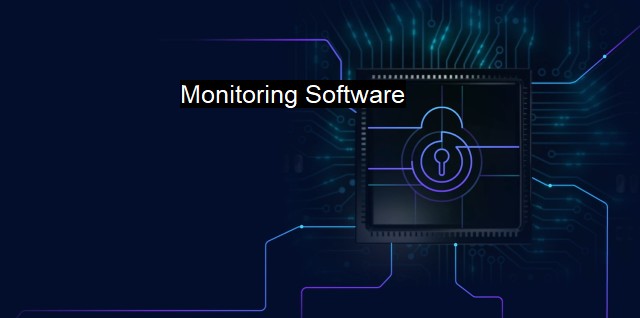What is Monitoring Software?
Strengthening Cybersecurity with Real-Time Surveillance: The Functionality and Significance of Monitoring Software
Monitoring software is a specialized tool designed to safeguard, oversee, and control the operations and functions of computer systems, networks, or applications and provide an extensive layer of protection against unauthorized access, data breaches, and a myriad of potential cyber threats.Monitoring software scrutinizes every single element of your computer in real time. This includes inbound and outbound data, the actions taken by users of the software and its components, file modifications, and much more. Such programs work tirelessly, scanning every byte of your computer with the purpose of catching and eliminating any mark of malicious content.
Monitoring software serves as a proactive defense; it arms organizations with an effectively efficient way of predicting, detecting, and combating cyber threats before they manifest. While antivirus software focuses on removing viruses and other malicious applications once they get access, monitoring software can stave off these threats beforehand. It identifies variations and trends out of the ordinary, constantly checking for possible breaches and flagging them for immediate attention.
One primary function of monitoring software is to perform data tracking. This process involves carefully examining and overseeing data flow within and across networks and applications. In doing so, it can uncover any deviations from the expected data patterns, which could indicate attempts at cyber infiltration, unauthorized access, or other cyber attack mechanisms. This essential attribute makes it indispensable in preventing data loss, data theft, and other similar digital crimes.
Monitoring software also plays an essential role in network security. Network monitoring tools within the software can track the status of network devices, ensuring these devices aren't being attacked. The use of these tools allows the tracking of an attacker's origin, behavior, and infiltration strategies, which helps in stomping possible attacks even before they happen and reduces the risk of further attacks.
One prominent aspect where cybercriminal activities often occur is internet use. Monitoring software helps to regulate and monitor current internet use and online activities across the organization's computers. In practice, this means observing websites being accessed, emails, downloads, and other web-based applications. By getting real-time updates on web use, companies can enforce safe internet usage policies and crack down on potentially harmful behavior.
More complex monitoring software can function as a malware detection system, too. These systems often work by spotting unusual patterns or changes within the system's operations. Once these signs are detected, the software alarms the administrators and pinpoints the problem area. This feature enables quick reaction time and strives to prevent the issue from exacerbating.
Equally critical are the records that monitoring software keeps for future reference. These logs consist of explicit details of attempts, successes, and failures at security breaches, attacks, unauthorized accesses, and other abnormalities. The logs also play an important part in providing data for forensic analysis during an attack.
While monitoring software is necessary for computer systems and networks in the fight against cyber attacks, it's also essential to understand that it's just a part of a more significant security plan. The software must be combined with other security measures like firewall protection, secure authentication procedures, strong and continually updated passwords, and regular audits and updates from the IT department to guarantee full system security.
Undeniably, monitoring software forms an integral part of cybersecurity and antivirus mechanisms, presenting an amalgamation of multiple features aiming at an airtight digital fortress. It showcases the proactive and progress-driven path taken in the fight against cyber crimes. It is the guardian to all digital realms, working ceaselessly to ensure an attack comes to nothing and eventually saving the day.

Monitoring Software FAQs
What is monitoring software?
Monitoring software is a type of software application used to track and monitor system and network activities. It provides insights into the performance and behavior of the system, allowing users to identify and mitigate security threats.What are the benefits of using monitoring software for cybersecurity?
Monitoring software plays a critical role in cybersecurity as it helps in identifying and responding to security threats in real-time. It enables organizations to detect and prevent security breaches, malware attacks, spyware, and other forms of cyber threats. Moreover, monitoring software provides data on system and network activities, which can be analyzed to improve security policies and procedures.How does monitoring software differ from antivirus software?
Monitoring software and antivirus software serve different purposes. Antivirus software is primarily designed to protect systems from malware infections by scanning files and applications for known viruses and malware. Monitoring software, on the other hand, monitors the system for suspicious behavior, unauthorized access, and other potential security threats.What are the different types of monitoring software for cybersecurity?
There are several types of monitoring software available for cybersecurity, including network monitoring software, log monitoring software, application performance monitoring software, and user activity monitoring software. Network monitoring software monitors network traffic and identifies any suspicious activities, log monitoring software analyzes log files to detect potential threats, application performance monitoring software tracks the performance of applications and services, while user activity monitoring software tracks user activities to identify potential security breaches.| | A | | | B | | | C | | | D | | | E | | | F | | | G | | | H | | | I | | | J | | | K | | | L | | | M | |
| | N | | | O | | | P | | | Q | | | R | | | S | | | T | | | U | | | V | | | W | | | X | | | Y | | | Z | |
| | 1 | | | 2 | | | 3 | | | 4 | | | 7 | | | 8 | | |||||||